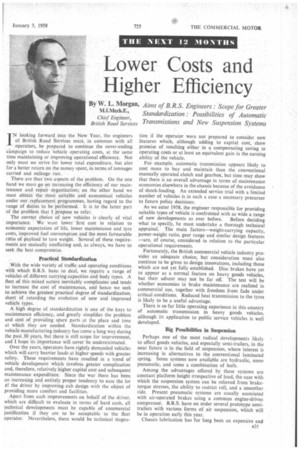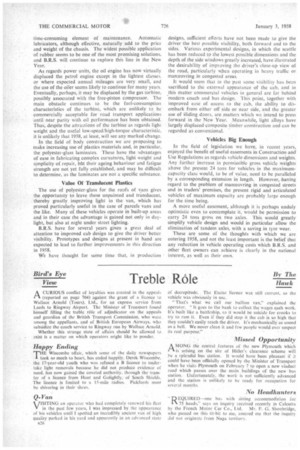Lower Costs and Higher Efficiency
Page 59

Page 60

If you've noticed an error in this article please click here to report it so we can fix it.
By W. L. Morgan,
miMech.E.,
Chief Engineer, British Road Services
IN looking forward into the New Year, the engineers of British Road Services must, in common with all operators, be prepared to continue the never-ending cimpaign to reduce Vehicle operating costs, at the same time maintaining or improving operational efficiency. Not only must we strive for lower total expenditure. but also for a better return on the money spent, in terms of tonnages carried and mileage run.
There are thus two aspects of the problem. On the one hand we must go on increasing the efficiency of our maintenance and repair organization; on the other hand we must obtain the most suitable and economical vehicles under our replacement programmes, having regard to the range of duties to be performed. It is to the latter part of the problem that I propose to refer.
The correct choice of new vehicles is clearly of vital importance. We want lower first cost in relation to economic expectation of life, lower maintenance and tyre costs, improved fuel consumption and the most favourable ratio of payload to tare weight. Several of these requirements are mutually conflicting and, as always, we have to seek the best compromise.
. Practical Standardization
With the wide variety of traffic and operating conditions with which B.R.S. have to deal, we require a range of vehicles of different carrying capacities and body types. A fleet of this mixed nature inevitably complicates and tends to increase the cost of maintenance, and hence we seek to achieve the greatest practical degree of standardization, short of retarding the evolution of new and improved vehicle types.
A high degree of standardization is one of the keys to maintenance efficiency, and greatly simplifies the problem and cost of providing spare parts at the place and time at which they are needed. Standardization within the vehicle manufacturing industry has come a long way during the past 30 years, but there is still scope for improvement, and I hope its importance will never be underestimated.
Over the years, operators have rightly demanded vehicles which will carry heavier loads at higher speeds with greater safety. These requirements have resulted in a trend of vehicle development which involves greater complication and, therefore, relatively higher capital cost and subsequent maintenance expenditure. Since the war there has been an increasing and entirely proper tendency to ease the lot if the driver by improving cab design with the object of providing more comfort and facilities.
Apart from such improvements on behalf of the driver, which are difficult to evaluate in terms of hard cash, all technical developments must be capable of commercial justification if they are to be acceptable to the fleet operator. Nevertheless, there would be technical stagna
tion if the operator were not prepared to consider new features which, although adding to capital cost, show promise of resulting either in a compensating saving in operating costs or at least an equivalent gain in the earning ability of the vehicle.
For' example, automatic transmission appears likely to cost more to buy and maintain than the conventional manually operated clutch and gearbox, but time may show that there is an overall advantage in terms of maintenance economies elsewhere in the chassis because of the avoidance ' of shock-loading. An extended service trial with a limited number of vehicles is in such a case a necessary precursor to future policy decisions.
As we enter 1958, the engineer responsible for providing suitable types of vehicle is confronted with as wide a range of new developments as ever before. Before deciding what to specify, he must undertake a thorough technical appraisal. The main factors—weight-carrying capacity, power-weight ratio, gear range and similar design features —are, of course, considered in relation to the particular operational requirements.
Fortunately, the British commercial vehicle industry provides an adequate choice, but consideration must also continue to be given to design innovations, including those which are not yet fully established. Disc brakes have yet to appear as a normal feature on heavy goods vehicles, but their advent may not be far off. The test will be whether economies in brake maintenance are realized in commercial use, together with freedom from fade under critical conditions. Reduced heat transmission to the tyres is likely to be a useful advantage.
There is so far little operating experience in this country of automatic transmission in heavy goods vehicles, although its application to public service vehicles is well developed.
Big Possibilities in Suspension
Perhaps one of the most radical developments likely to affect goods vehicles, and especially semi-trailers, in the near future is in the field of suspension, where interest is increasing in alternatives to the conventional laminated spring. Some systems now available are hydraulic, some pneumatic, and some a combination of both.
Among the advantages offered by these systems are constant platform height irrespective of load, the ease with which the suspension system can be relieved from braketorque stresses, the ability to restrict roll, and a smoother ride. Present pneumatic systems are usually associated with air-operated brakes using a common engine-driven compressor. B.R.S. have on order several prototype semitrailers with various forms of air suspension, which will be in operation early this year.
Chassis lubrication has for long been an expensive and n25
time-consuming element of maintenance. Automatic lubricators, although effective, naturally add to the price and weight of the chassis. The widest possible application of rubber seems to be one of the most promising solutions. and B.R.S. will continue to explore this line in the New Year.
As regards power units, the oil engine has now virtually displaced the petrol engine except in the lightest classes. or where expected annual mileages are very small, and the use of the oiler seems likely to continue for many years. Eventually, perhaps, it may be displaced by the gas turbine, possibly associated with the free-piston compressor. The main obstacle continues to be the fuel-consumption characteristics of the turbine, which are unlikely to be commercially acceptable for road transport applications until near parity with oil performance has been obtained. Thus, despite the attractions of the turbine as regards light weight and the useful low-speed/high-torque characteristic. it is unlikely that 1958, at least, will see any marked change.
In the field of body construction we are proposing to make increasing use of plastics materials and, in particular, the polyester-glass laminates. These have the advantages of ease in fabricating complex curvatures, light weight and simplicity of repair, brit their ageing behaviour and fatigue strength are not yet fully established, and may be difficult to determine, as the laminates are not a specific substance.
Value Of Translucent Plastics
The use of polyester-glass for the roofs of vans gives the opportunity to leave these unpainted and translucent, thereby greatly improving light in the van, which has proved particularly usefid in the case of parcels vans and the like. Many of these vehicles operate in built-up areas and in their case the advantage is gained not only in daylight, but also at night under street lighting.
B.R.S. have for several years given a great deal of attention to improved cab design to give the driver better visibility. Prototypes and designs at present in hand are expected to lead to further improvements in this direction in 1958.
We have thought for some time that, in production designs, sufficient efforts have not been made to give the driver the best possible visibility, both forward and to the sides. Various experimental designs, in which the scuttle has been reduced to the lowest possible dimensions and the depth of the side windows greatly increased, have illustrated the desirability of improving the driver's close-up view of the road, particularly when operating in heavy traffic or manwuvring in congested areas.
It would seem that in the past some visibility has been sacrificed to the external appearance of the cab, and in this Matter commercial vehicles in general are far behind modern coach and bus design. This point, together with improved ease of access to the cab, the ability to disembark from either off side or near side, and the greater use of Sliding doors. are matters which we intend to press forward in the New Year. Meanwhile, light alloys have Largely displaced composite timber construction and can be regarded as conventional.
Vehicles Big Enough
In the field of legislation we have, in recent years, enjoyed the benefit of useful easements in Construction and Use Regulations as regards vehicle dimensions and weights. Any further increase in permissible gross vehicle weights above the present 24 tons for vehicles in the maximumcapacity class would, to be of value, need to be paralleled by a corresponding extension in length. However, baying regard to the problem of manceuvring in congested streets and in traders' premises, the present rigid and articulated vehicles of maximum capacity arc probably large enough for the time being.
A more useful easement, although it is perhaps unduly optimistic even to contemplate it, would be permission to carry 24 tons gross on two axles. This would greatly simplify vehicle design and would in particular allow the elimination of tandem axles, with a saving in tyre wear. These are some of the thoughts with which we are entering 1958, and not the least important is the belief that any reduction in vehicle operating costs which B.R.S. and other fleet owners can achieve is clearly in the national interest, as well as their own.




































































































